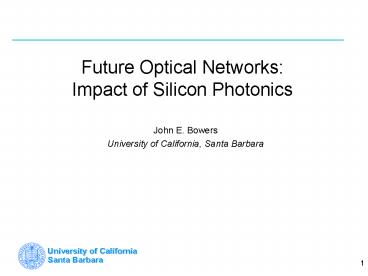Future Optical Networks: Impact of Silicon Photonics - PowerPoint PPT Presentation
1 / 6
Title:
Future Optical Networks: Impact of Silicon Photonics
Description:
PICs with interface and drive electronics, and tens of lasers, modulators and PDs cost $1. ... How to make silicon PICs for a penny a PIC. ... – PowerPoint PPT presentation
Number of Views:259
Avg rating:3.0/5.0
Title: Future Optical Networks: Impact of Silicon Photonics
1
Future Optical NetworksImpact of Silicon
Photonics
- John E. Bowers
- University of California, Santa Barbara
2
Where is Silicon Photonics Heading?
Silicon Evanescent Amplifier
- Integration with CMOS electronics
- 100,000 electronic and photonic devices/die
- Redundant elements
- Self testing, flexible, software controlled IO
formats - High yield, High reliability
- Laser, amplifier, modulator, photodetectors,
delay lines, AWGs on chip
PDs
Silicon Evanescent Laser
3
What does VLSI Photonics Require?
- 100,000 electronic and photonic devices/die
- CMOS Integration
- Redundancy
- Self testing, flexible, software controlled IO
formats - High yield
- High reliability
- Laser, amplifier, modulator, photodetectors, low
loss delay lines, optical buffers, AWGs on chip
Suppose Silicon Photonics is able to do this by
2008. What is the impact in 2010-2015?
4
Cost
- 6 wafer has 73,000 0.5 mm sized die sites.
- Cost per laser
- PICs Laser size 10x100 microns.
- Cost per laser 0.00002
- This is just like estimating the cost of
transistors. They are free. Only the PIC cost
matters. - Lasers, modulators, photodetectors will be free.
5
PIC Cost
- CMOS die cost 1/cm2
- Hybrid silicon evanescent PIC cost 2/cm2
- PICs with interface and drive electronics, and
tens of lasers, modulators and PDs cost
Example Silicon DWDM Transmitter
6
Future Optical Networks
- Transceivers will be cheap and ubiquitous hence
the network must scale to millions or more
transceivers. - Transmitters and receivers will adapt to the
channel characteristics. - Data rates will self adjust depending on the
channel quality. - Networks will be reconfigurable and adaptable.
- Challenge
- How to make use of billions of elements on the
network. - How to make silicon PICs for a penny a PIC.































